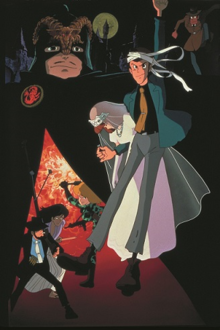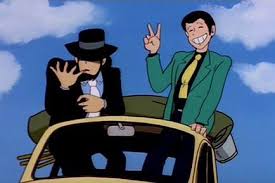|
“Lupin III: The Castle of Cagliostro” stars Yasuo Yamada, Sumi Shimamoto, Tarō Ishida, Gorō Naya, Kiyoshi Kobayashi, and Eiko Masuyama. Released on December 15, 1979, the film is about a gentleman thief who sets out to rescue a princess from the clutches of an evil count. The film featured the directorial debut of Hayao Miyazaki, and it is based on the manga series, Lupin III, by Monkey Punch. Before Miyazaki made it big with Studio Ghibli, he was once a regular animator for Toei Animation and TMS Entertainment. With the success of the first Lupin III feature film, The Mystery of Mamo, in 1978, another film based on the character was put into production with Miyazaki coming on board to direct for the first time. Now this wasn’t the first time that Miyazaki worked on the source material as he had directed several episodes of the Lupin III anime shows. Upon its release, it received numerous amounts of praise from critics, and it sparked a major influence for filmmakers as well as animators, including Pixar chief John Lasseter. As a person who has been following Miyazaki’s works for quite some time, I had not heard of the source material nor had I gotten the chance to even see this film. When I heard that my closest cinema is showing it for a limited time, I knew for a split second that I wouldn’t let this chance slip by again. So, I finally took a chance to see it for the first time on the big screen, and my God, it was worth it. The film’s story follows its usual hero-rescues-the-damsel plot that influenced several other films after it, with the hero being a charming thief, a damsel in distress being a beautiful princess, and a sinister villain being the count who wants to marry the princess in order to obtain the ancient treasure of Cagliostro. This type of story, to me, has a unique ability to offer a fun, simple, and thrilling experience that’s pleasing to the eyes and the minds of animation fans, and yes, I did have a fun time watching it despite having little to no idea who these characters are. I think this is what Hollywood is struggling to accomplish in recent years when it comes to adapting the source material for a wide audience. In the case of “Castle of Cagliostro”, if you’re a big fan of the Lupin III manga series, then there’s a good chance that you’ll appreciate the film’s faithfulness to the characters and the concept. If you’re a newcomer like me, you’ll still be able to have fun tagging along with these characters, especially Lupin III and his colleague, Daisuke Jigen. The best part is that it doesn't involve a long backstory for each character that disrupts the story’s pacing. It just goes by at a suitable pace without sacrificing the amount of depth that’s put into the characters and the action. It’s the type of story that we’ve seen before, but Miyazaki handled it in the most clever way possible. I got a chance to view the English dub version of the film, and while some of the dialogue from that version sounded a little…flat, the English cast did a somewhat decent job at voicing their respective characters. The animation still looks gorgeous and well-crafted as it was during its original release despite its flow being a bit rough, which seems understandable since it came out in the late 1970s. Not only did the animation work wonders on the character designs and the locations, but also on the cinematography and the action sequences, most notably the car chase sequence, which offers a good amount of fun and intensity compared to any other live-action film that involves a car chase scene. The musical score by Yuji Ohno was also fun to listen to as it remarkably reflects on the wacky scenes as well as the adventurous scenes. Although, I still like the musical scores of Joe Hisaishi a bit better in terms of Miyazaki’s filmography because of their unique tones. Overall, Hayao Miyazaki’s directorial debut, “Lupin III: The Castle of Cagliostro” is a splendid piece of Japanese animation cinema, in my opinion. Filled with fun characters, a well-effective story, and amazing animation, this film definitely has the tendency to continue being a remarkable influence for many animators and directors for many years to come. It’s pretty hard to believe that Miyazaki’s first film as a director actually became one of his greatest achievements in his career, but after watching it for the first time, I can fully understand why. It’s pretty much his own way of creating imaginative stories that changed how we see animated films today. Not as cartoons that are made for kids, but as an art form. That’s basically my assumption on this concept, but feel free to disagree if you want. If you haven’t seen this film yet and you’re a huge fan of Miyazaki, it’s definitely worth checking out. A
0 Comments
Leave a Reply. |
Home of the most friendly movie reviews on the planet.
Categories
All
Follow Me |
- Home
- Classic Reviews
- 2015 Reviews
- 2016 Reviews
- 2017 Reviews
- 2018 Reviews
- 2019 Reviews
- 2020 Reviews
- 2021 Reviews
- 2022 Reviews
- 2023 Reviews
- 2024 Reviews
- Movie Talk
-
Fan Fictions
-
Ed, Edd n Eddy: The Ultimate Ed-Chronicles
>
-
The 'Beginnings' Saga
>
- Ed, Edd n Eddy: The Rise of Maleficent >
- Transformers: Legend of the Black Cauldron >
- Ed, Edd n Eddy meets the Penguins of Madagascar >
- The Eds and Iron Man: Dawn of the Blowhole >
- Ed, Edd n Eddy: The Fast and the Furious >
- The Eds and Kung Fu Panda: Battle for China >
- Ed, Edd n Eddy and the Lion King: The Full Circle >
- Ed, Edd n Eddy meets Thumbelina: Revenge of the Shredder >
- Ed, Edd n Eddy: Journey to Neverland >
- Ed, Edd n Eddy: All Tangled Up >
- Ed, Edd n Eddy's Frozen Adventure >
- Ed, Edd n Eddy's Edventures in San Fransokyo
- Ed, Edd n Eddy: Return to Neverland
- Ed, Edd n Eddy vs The League of Evil
-
The 'Avengers' Saga
>
- The Eds and the Little Mermaid: Age of Extinction
- Ed, Edd n Eddy meets the Ghostbusters
- Ed, Edd n Eddy: A Sea of Adventure
- Ed, Edd n Eddy meets Anastasia
- Ed, Edd n Eddy in Who Framed Roger Rabbit?
- Ed, Edd n Eddy meets the Incredibles
- Ed, Edd n Eddy and the Lion King 2: Simba's Pride
- Ed, Edd n Eddy: Brand New Zootopia
- Ed, Edd n Eddy: Into the Sugar Rush
- Ed, Edd n Eddy and the Big Sea Quest
- Ed, Edd n Eddy: Heroes Assemble
- Fastformers: Rio Heist
- The Loud Ghostbusters >
-
The 'Beginnings' Saga
>
-
Ed, Edd n Eddy: The Ultimate Ed-Chronicles
>
- Contact
- About


